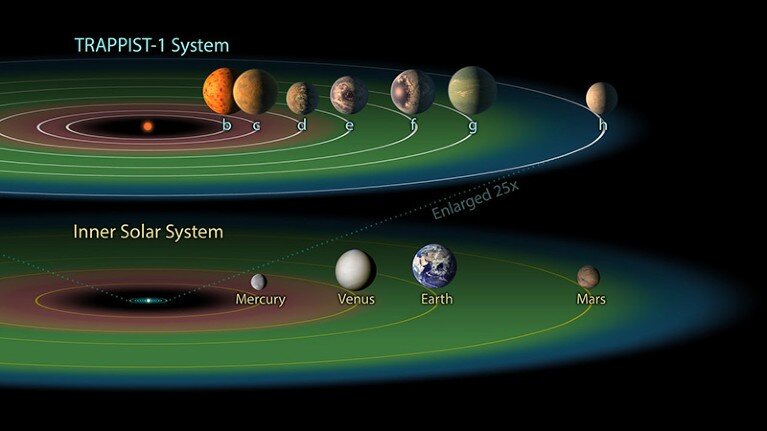Laurence Tognetti writes:
In a recent study published in the Astrophysical Journal Letters, an international team of researchers led by the University of Cologne in Germany examined how solar flares erupted by the TRAPPIST-1 star could affect the interior heating of its orbiting exoplanets.

This study holds the potential to help us better understand how solar flares affect planetary evolution. The TRAPPIST-1 system is an exoplanetary system located approximately 39 light-years from Earth with at least seven potentially rocky exoplanets in orbit around a star that has 12 times less mass than our own sun. Since the parent star is much smaller than our own sun, then the the planetary orbits within the TRAPPIST-1 system are much smaller than our own solar system, as well. So, how can this study help us better understand the potential habitability of planets in the TRAPPIST-1 system?
“If we take Earth as our starting point, geological activity has shaped the entire surface of the planet, and geological activity is ultimately driven by planetary cooling,” said Dr. Dan Bower, who is a geophysicist at the Center for Space and Habitability at the University of Bern, and a co-author on the study.
“The Earth has radioactive elements in its interior which generate heat and enable geological processes to persist beyond 4.5 Gyr. However, the question arises if all planets require radioactive elements to drive geological processes that may establish a habitable surface environment that allows life to evolve. Although some other processes can generate heat inside a planet, they are often short-lived or require special circumstances, which would advance the hypothesis that geological activity (and habitable environments?) are possibly rare.”
What makes this study intriguing is that TRAPPIST-1 is known as an M-type star, which is much smaller than our sun and emits far less solar radiation.
“M stars (red dwarfs) are the most common star type in our stellar neighborhood, and TRAPPIST-1 has garnered significant attention since it was discovered to be orbited by seven Earth-sized planets,” explained Dr. Bower.
In our study, we investigated how stellar flares from TRAPPIST-1 impacted the interior heat budget of the orbiting planets and discovered that particularly for the planets closest to the star, interior heating due to ohmic dissipation from flares is significant and can drive geological activity. Furthermore, the process is long-lived and can persist over geological timescales, potentially enabling the surface environment to evolve towards habitable, or pass through a series of habitable states. Previously, the influence of stellar flares on habitability has mostly been deemed to be destructive, for example by stripping the protective atmosphere that enshrouds a planet. Our results present a different perspective, showing how flares may actually promote the establishment of a habitable near-surface environment.”
Note: Low-mass M stars (red dwarfs) are known to have elevated levels of ultraviolet flaring and stellar winds, which are deleterious for life (see the quotes below from an article by astrophysicist Hugh Ross).
The MTS team showed that for even the low mass stars that are the quietest at optical wavelengths, the flux of ultraviolet and soft x-rays is sufficient to erode the atmospheres of planets orbiting these stars that reside in the liquid water habitable zone.3 They also demonstrated that these stars emit powerful ultraviolet flares.4
The second recent finding was the result of a detailed three-dimensional magnetohydrodynamic modeling of the impact of the stellar wind from the TRAPPIST-1 star on its system of seven planets. The team of five astronomers who calculated the model showed that the TRAPPIST-1 planets experience a stellar wind pressure between 1,000 and 100,000 times greater than the solar wind pressure on Earth.7 They also established that for all plausible planetary magnetic field strengths, the magnetospheres of the TRAPPIST-1 planets would be so compressed that they would not prevent the direct flow of stellar wind particles upon the planetary atmospheres. Consequently, all the TRAPPIST-1 planets have had their atmospheres and surface water stripped away.
It seems that by saying, “Our results present a different perspective, showing how flares may actually promote the establishment of a habitable near-surface environment,” the researchers are closing their eyes to the unsuitable conditions for life on the TRAPPIST-1 planets and overstating any beneficial outcome of high levels of UV flaring. It’s worth realizing that if the energy from stellar flaring is sufficient to noticeably heat the entire planet, it’s more than enough to “cook its goose.”